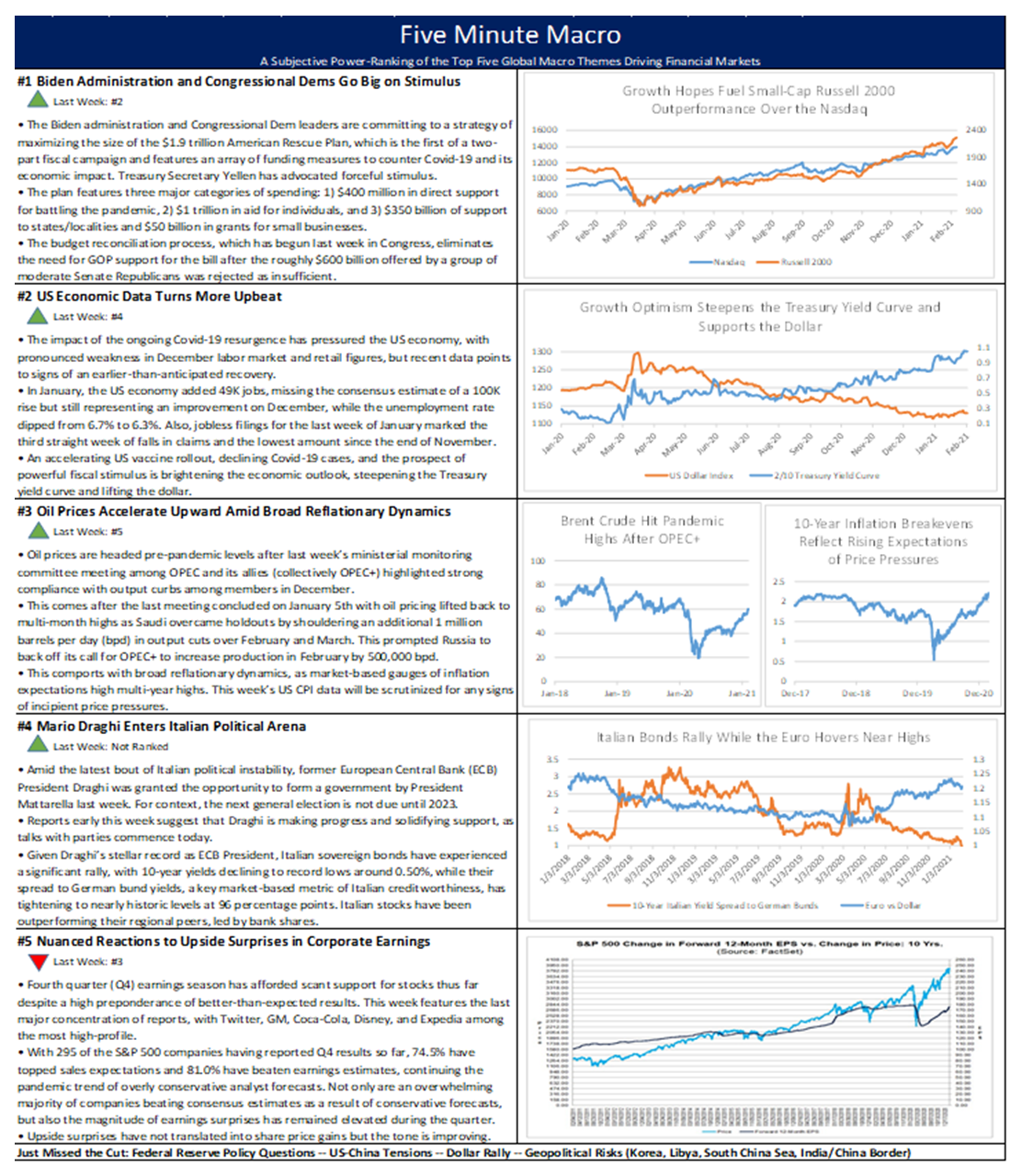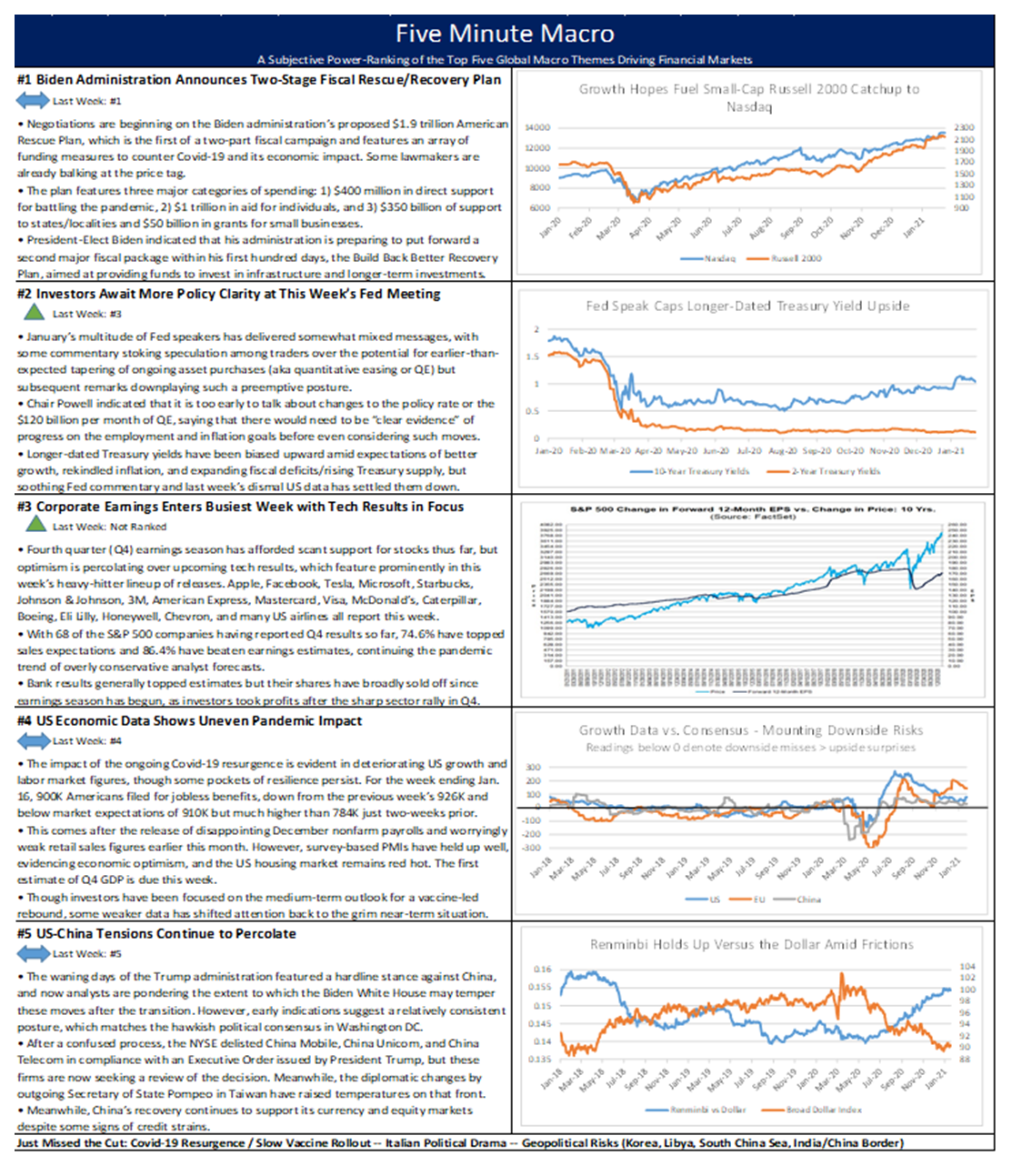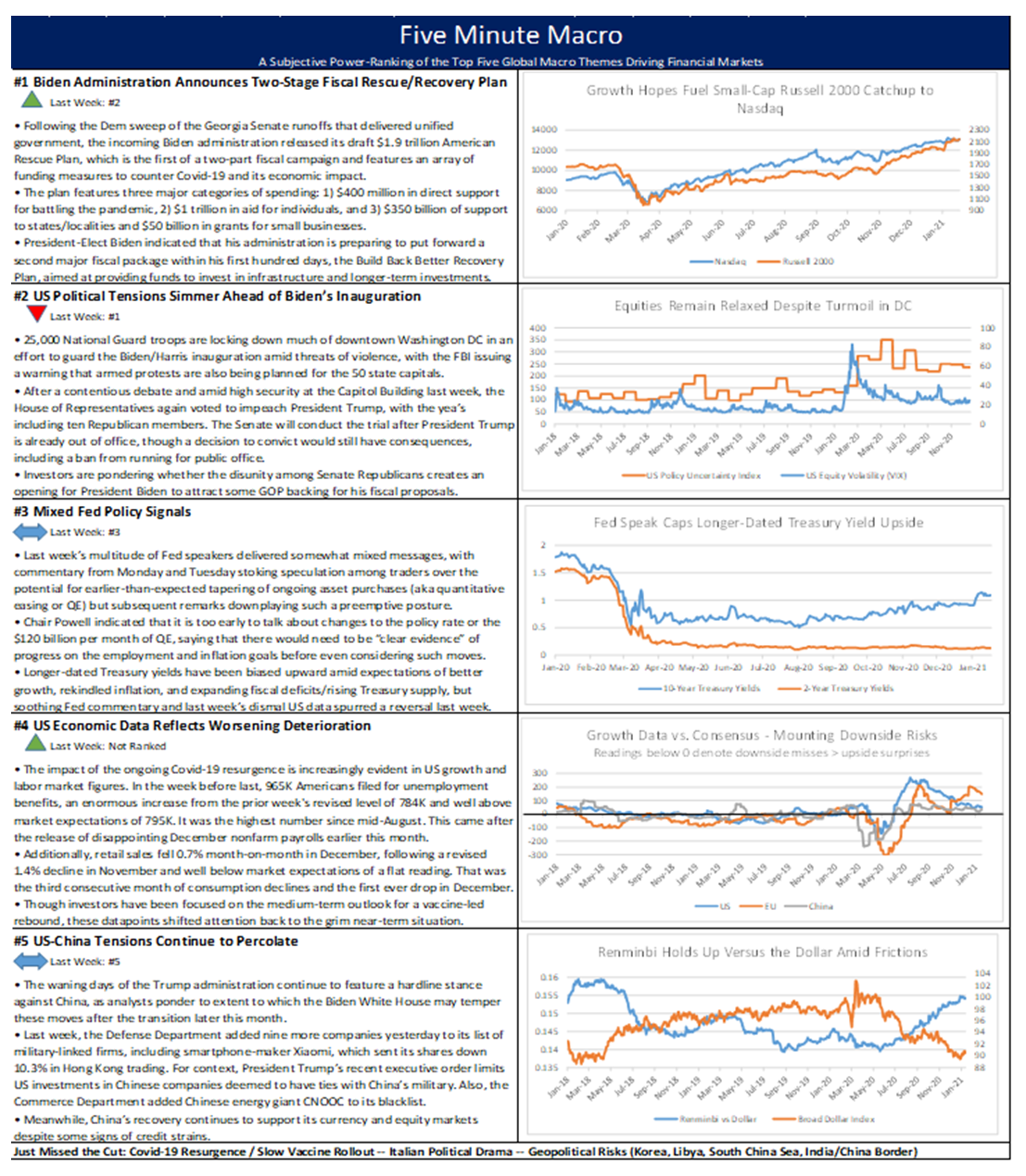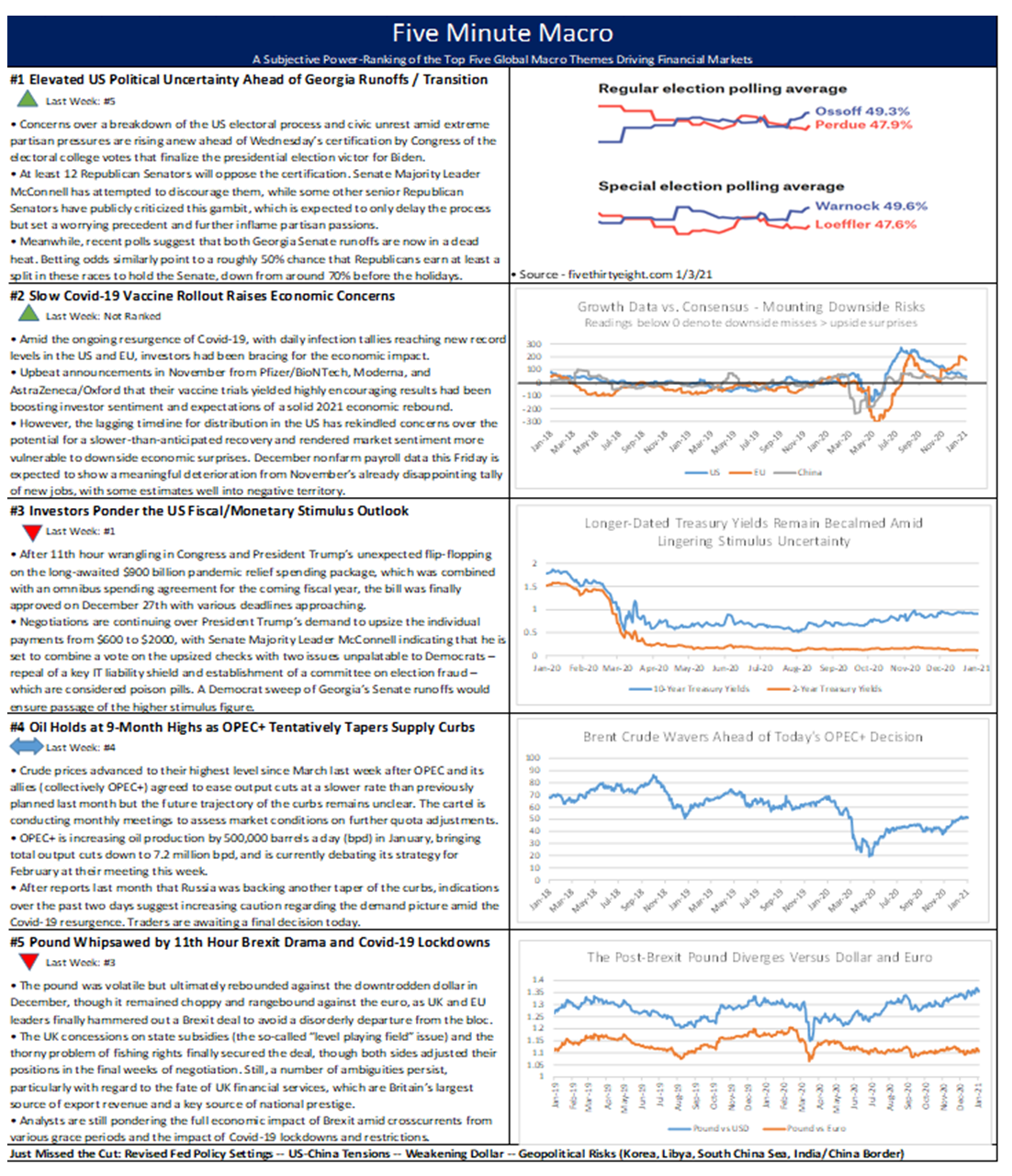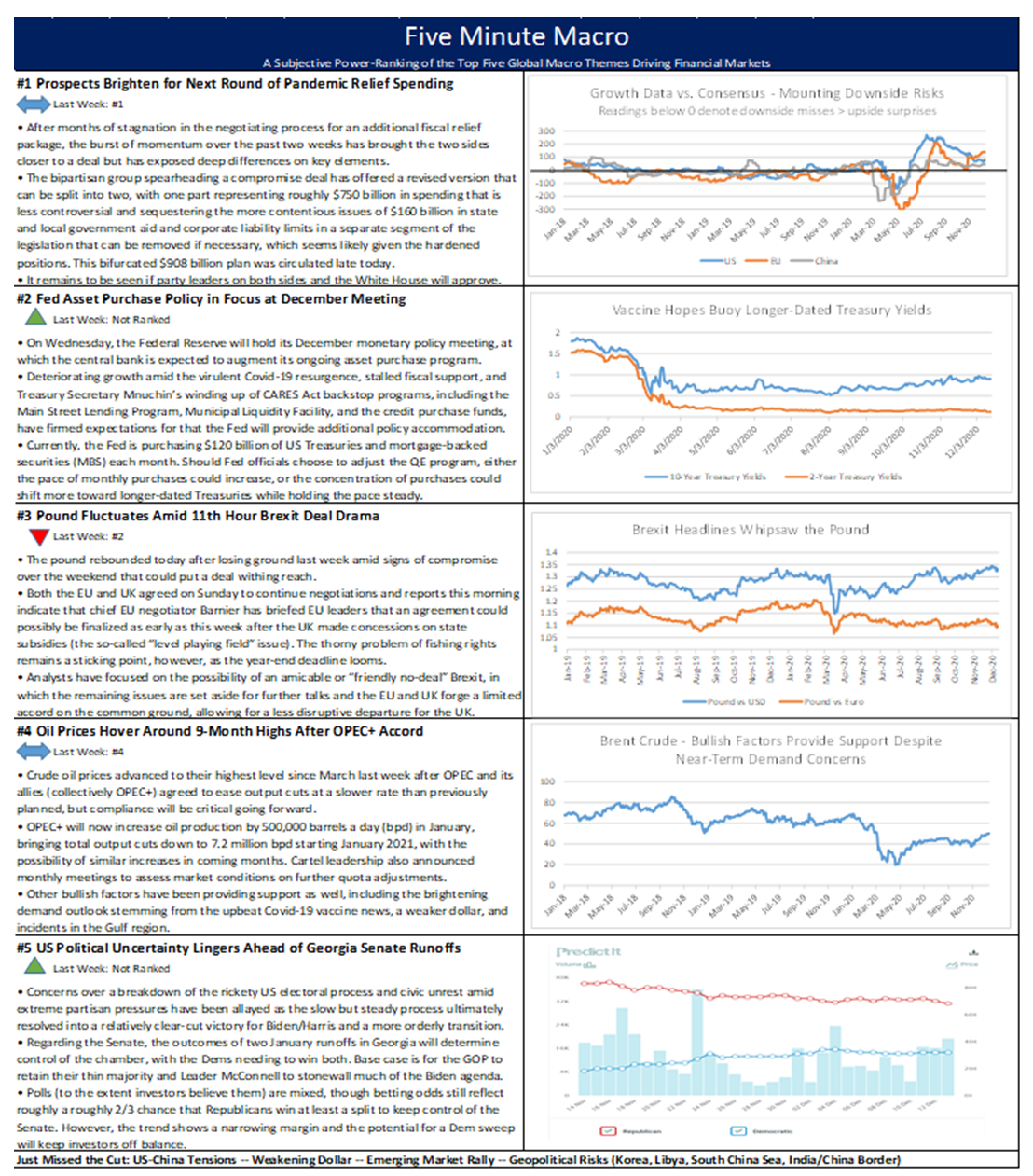Looking Ahead – The Future’s So Bright, I Gotta Wear Shades
After a year that featured so many surprises, and not many pleasant ones, it is a testament to both the natural human tendency toward optimism, as well as miracles of biomedical science, that 2021 can be a repository for so many positive and tantalizing expectations. The strong prospects for a V-shaped recovery not only in the economy but for our collective well-being are underpinned by a trio (at least) of highly effective vaccines that are being distributed with tireless efficiency by our logistical networks. Anticipation of a return to relative normalcy in the not-too-distant future is not only a psychological bulwark against the stresses and troubles of the present but is also a reasonably likely base-case scenario.
The reality could be more nuanced, as uneven supply and tentative public uptake of the vaccine may be factors that lengthen out the timeline for defeating Covid-19. But questions of pacing aside, 2021 seems almost certain to be showing us the way to brighter days ahead, particularly after the dark months of winter finally give way to spring and then summer. Investors are, of course, already flashing-forward to this upbeat future. Market participants know that growth will rebound after tipping into what might amount to a brief double-dip recession this winter. But whether faster or slower than consensus, how can growth not improve alongside increasingly widespread vaccine distribution? Meanwhile, the Fed has promised to stay ultra-easy; more pandemic relief spending is almost certainly on the way from Capitol Hill (with a greater front-loaded magnitude than we had expected, it appears); inflation seems highly likely to remain in abeyance; the trajectory of dollar depreciation is already well established; and the Treasury yield curve steepening trend is gradual but seemingly inexorable; and last but not least, buoyant stocks appear set to either run higher or a lot higher. Through the lens of the markets, 2021 looks almost – dare we say it – predictable?
Amid all this apparent predictability resides one glaring unknown – the outcome of the two Senate runoffs in Georgia on January 5th, which will decide control of the chamber. A leading prediction market reflects roughly 2/3 odds that the GOP get at least a split, leaving meaningful residual odds that the Dems sweep and take back control of the Senate by the thinnest of margins. Other aspects also feed the uncertainty:
- Polls are untrustworthy
- Unprecedented resources are pouring in
- Large absentee ballot factor again
- Messaging issues for GOP (local authorities pushing election security, Trump and supporters saying it was rigged and blasting their handling of it)
It is worth noting that moderate Dems may not be too upset to see the GOP keep control of the Senate if that occurs, as it would absolve them of any pressure to “change the world” and they can spend two years setting their policies up, trying them out, and painting McConnell and the Senate GOP as obstructionists for not passing any of the bills they are sent – infrastructure is a good example of this. Then, for the midterm elections in 2022, the Senate electoral math is firmly in the Dems’ favor as they only have to contest 13 seats versus 20 for Republicans.
In short, there can only be low conviction about the high-impact outcome in Georgia. The two vastly divergent alternate policy realities of the two possible outcomes are shown below:
Looking ahead, the year-end period will feature at least a few more days of continued drama on Capitol Hill over the pandemic relief bill and government funding deadline. Meanwhile, we expect Brexit negotiations to run over the Sunday deadline, and then the year-end departure date, but be accompanied by both sides trying to play up the “amicable divorce” angle, with promises to keep negotiating, even as the economic reality of the UK’s departure from the EU looks more like a disorderly Brexit. Meanwhile, the entire US political landscape will pivot around the Georgia Senate runoffs on January 5th, with control of the chamber and the Biden administration’s policy wishlist hanging in the balance.
The regular macro calendar for the coming weeks until January 8th features some global PMI data and the December nonfarm payroll report on that second Friday in January, when we will publish our first Looking Ahead of 2021. Have the happiest of holidays!
- Nonfarm Payrolls
- Global PMIs
- US Personal Income, Spending & Inflation
Global Economic Calendar: Auld Lang Syne
December 22
The day begins with the GfK Consumer Climate Indicator in Germany. Heading into December the GfK dropped to a five-month low of -6.7, from a revised -3.2 in the prior month and below market consensus of -5, as sentiment was hit by a partial lockdown to curb a second coronavirus wave. The gauge for economic outlook fell 7.3 points to -0.2, the lowest figure since May of this year when it stood at -10.4. Also, the income expectations sub-index declined 5.2 points to 4.6, and the willingness to buy indicator dropped 6.5 points to 30.5. GfK consumer expert Rolf Buerkl stated, “How the infection rate develops in the coming weeks will play a decisive role in determining whether the consumer climate will be able to stabilize again. Only a significant decrease in the number of infections and an easing of restrictions will restore a more optimistic outlook.”
The US brings the Final Estimate of US 3rd Quarter GDP. The second estimate showed the US economy expanded by an annualized 33.1%, in line with the advance estimate. It is the largest expansion ever, following a record 31.4% plunge in Q2, as the economy rebounds from the coronavirus pandemic. Upward revisions to business and housing investment, and exports were offset by downward revisions to personal and public consumption and private inventory investment. Still, personal spending was the main driver of growth, helped by checks and weekly unemployment benefits from the federal CARES Act. However, GDP is still 3.5% below its pre-pandemic level.
December 23
The focus of the day will be on the US Personal Income and Spending. In October personal income fell by 0.7% m/m, following a downwardly revised 0.7% increase in the previous month and compared with market expectations of a flat reading. The decrease in government social benefits was mostly to blame because of a drop in Lost Wages Supplemental Payments, a Federal Emergency Management Agency program that provides wage assistance to individuals impacted by the pandemic. In contrast, compensation and proprietors’ income rose. On a positive note, personal spending increased 0.5%, following a downwardly revised 1.2% growth in September and slightly beating market forecasts of 0.4%. Personal spending increased 0.5% m/m, following a downwardly revised 1.2% growth in September and slightly beating market forecasts of 0.4%. Real PCE rose 0.5%, boosted by increases in spending for both goods and services. Consumption of goods advanced 0.2%, boosted by recreational goods and vehicles. In addition, spending on services was up 0.6% due to health care spending. Additionally, The PCE price index was unchanged in October, following a 0.2% gain in September, as a 0.1% increase in services cost offset a 0.2% decline in goods prices. Within goods, prices were down for nondurable goods and durable goods. Core PCE, which excludes food and energy, were also flat in October, in line with market expectations. Year-on-year, the PCE price index advanced 1.2% and Core PCE increased 1.4%.
December 24
Christmas Eve brings US Durable Goods Orders. In October new orders increased 1.3% m/m, easing from an upwardly revised 2.1% rise in September and above market expectations of 0.9%. It is the sixth consecutive gain in durable goods orders. Excluding transportation, new orders rose 1.3% and excluding defense, new orders went up 0.2%. Orders slowed for transportation equipment and capital goods and computers and electronics. Orders for non-defense capital goods excluding aircraft, a closely watched proxy for business spending plans, increased 0.7%, following a 1.9% rise in September.
January 3
The Caixin China General Manufacturing PMI rose to 54.9 in November from 53.6 in October and beating market estimates of 53.5. This was the seventh straight month of growth in factory activity and the strongest since November 2010, as the post epidemic economic recovery continued to pick up speed. Both output and new orders rose at the fastest rate in a decade, employment grew the most since May 2011 and new orders rose further. Also, buying levels increased at the steepest pace since the start of 2011, with stocks of purchases rising the most since February 2010. At the same time, capacity pressures persisted, with the rate of backlog accumulation being the quickest since April. Meanwhile, the active market led to longer delivery times from suppliers. On the price front, the gauges for input and output prices rose further into expansionary territory. Looking ahead sentiment remained strongly positive, despite easing slightly since October.
January 5
The ISM Manufacturing PMI fell to 57.5 in November from a two year high of 59.3 reached in October. The PMI came slightly lower than market forecasts of 58, but still pointed to expansion in the overall economy for the seventh month in a row. A slowdown was seen in production, new orders and inventories while employment contracted. On the other hand, new export orders increased faster. Timothy R. Fiore, Chair of the ISM Manufacturing Business Survey Committee said, “The manufacturing economy continued its recovery in November. Survey Committee members reported that their companies and suppliers continue to operate in reconfigured factories, but absenteeism, short-term shutdowns to sanitize facilities and difficulties in returning and hiring workers are causing strains that will likely limit future manufacturing growth potential. Panel sentiment, however, is optimistic.”
January 6
The Consumer Confidence Index in Japan edged up to 33.7 in November, the highest since February but below pre-pandemic levels. Two out of the main sub-indices improved, overall livelihood and income growth. Furthermore, the sub-indice of willingness to buy durable goods was stable, while that of employment perceptions weakened.
The ADP Employment Report estimated that private businesses in the US hired 307K workers in November, below an upwardly 404K in October and market forecasts of 410K. It is the smallest increase in four months as a rise in COVID-19 infections and further lockdowns slowed down the hiring. The service-providing sector added 276K jobs led by leisure and hospitality with 95K, education and health with 69K, professional and business with 55K, trade, transportation & utilities with 31K, other services with 18K and financial activities with 8K, while the information sector added none. The goods-producing sector created 31K jobs, due to construction with 22K, manufacturing with 8K, and natural resources and mining with 1K. Private payrolls in midsized companies were up 139K, small firms added 110K, and large companies 58K.
Australia’s Balance of Trade increased to AUD 7.46 bil in October from an upwardly revised AUD 5.82 bil in September. This was the biggest trade surplus since April, amid improving global demand as more countries reopen their economies following an easing of COVID-19 lockdowns. Exports rose 5% to AUD 35.72 bil, while imports edged up 1% to AUD 28.26 bil. Considering the first ten months of the year, the trade surplus widened slightly to AUD 60.92 bil from AUD 59.24 bil in the same period of 2019.
January 7
Canada’s Balance of Trade narrowed slightly to CAD 3.76 billion in October from an upwardly revised CAD 3.82 bil. Exports rose 2.2% to CAD 46.5 bil, the highest since February, partially on higher exports of pharmaceutical products. Meantime, imports increased at a softer 1.9% to CAD 50.23 bil, the highest since October last year in part due to higher imports of cell phones. Canada’s trade surplus with the US widened to CAD 3 bil from CAD 1.7 bil in September, as exports went up 2.0% while imports dropped 2.3%. The trade gap with countries other than the US widened to CAD 6.8 bil from CAD 5.5 bil, with imports rising 9.1% and exports climbing 2.7%.
The US Trade Deficit widened to $63.1 bil in October from a revised $62.1 bil and compared to market expectations of $64.8 bil. Exports increased 2.2% to $182 bil in 2020, while imports rose 2.1% to $245.1 bil, reflection both the ongoing impact of the COVID-19 pandemic and the continued recovery from the sharp declines earlier this year.
The Ivey PMI for Canada fell to 52.7 in November from 54.5 and missing market expectations of 54.7. It was the lowest reading since May, amid the ongoing tightening of some COVID-19 restrictions to curb a second wave of infections. Employment and supplier deliveries decreased, while inventories rose and price pressures intensified.
The ISM Non-Manufacturing PMI fell to 55.9 in November from 56.6, in line with forecasts of 56. The reading pointed to the slowest increase in the services sector in six-months, but it remained above the long-term average of 54.6. Production and new orders slowed, inventories contracted, and price pressures eased while employment rose at a faster pace. “Respondents’ comments are mixed about business conditions and the economy. Restaurants continue to struggle with capacity constraints and logistics. Most companies are cautious as they navigate operations amid the pandemic and the aftermath of the US presidential election,” Anthony Nieves, Chair of the ISM Services Business Survey Committee said.
January 8
Germany’s Trade Surplus narrowed slightly to €19.4 bil in October from €21.3 bil a year earlier. Exports shrank 6.5% y/y to €112 bil, the 8th straight annual decline and imports fell 5.9% to €92.7 bil, the 10th consecutive drop. Exports to the Euro Area went down 5.1% and those to the UK sank 11.7%. Sales to the US, which have been hit particularly hard by the coronavirus pandemic, dropped 10.5% while sales to China edged up 0.3%. Imports to the Euro Area decreased 2.9% and those from the UK were down 14.7%. Purchases from China slumped 3.3%, those from the US 18.8% and from the UK 17.6%. Adjusted for calendar and seasonal effects, exports were still 6.8% and imports 5.2% lower than in February of 2020, the month before restrictions were imposed due to the coronavirus pandemic.
The Canadian Employment Report showed the economy created 62K jobs in November, well above forecasts of a 20K rise and after an 83.6K increase in October. This is the lowest number since the recovery began six months ago as full-time work went up by only 99K and 37K part-time jobs were shed. Self-employment stalled and compared to public sector and private sector employees, employment in this group remained furthest from the February pre-COVID level. Increases were seen in Ontario, British Columbia and in all four Atlantic provinces. Employment growth resumed in the goods-producing sector in November, with most of the increase in construction. At the same time, employment in the services-producing sector was little changed, for the first time since the recovery began in May. Among youth aged 15 to 24, employment rose 0.9% from October, while the youth unemployment rate fell 1.4 percentage points to 17.4%.
The US Nonfarm Employment Report showed that the US economy added 245K jobs in November, easing from a downwardly revised 610K, and well below market expectations of 469K. It was the smallest employment gain since the job market started to recover in May from a record 20.787 mil loss in April. In November, nonfarm employment was below its February level by 9.8 mil, or 6.5%. Employment declined in government and retail trade while gains occurred in transportation and warehousing, professional and business services, and health care. The unemployment rate edged down to 6.7% from 6.9% and compared with market expectations of 6.8%, as fewer people looked for work. The number of unemployed persons fell by 326K to 10.7 mil and the employment level declined by 74K to 149.7 mil. The labor force participation rate edged down to 61.5% in November, 1.9% points below its February level. The employment-population ratio was little-changed at 57.3%, 3.8% points lower than in February.
The CPI in China unexpectedly declined by 0.5% y/y in November, after a 0.5% rise a month earlier and compared with market consensus of a flat reading. This was the first deflation rate since October of 2009 as food prices dropped for the first time in nearly three years, with prices of pork tumbling after soaring last year due to the African Swine outbreak. Also, there were falls in cost of transport, rent, fuel, and utilities, and clothing. Meanwhile, prices of household goods and services were flat, while cost rose for health, education, and other goods and services. On a monthly basis, the CPI fell by 0.6%, the steepest drop since May, and following a 0.3% decline in October.

